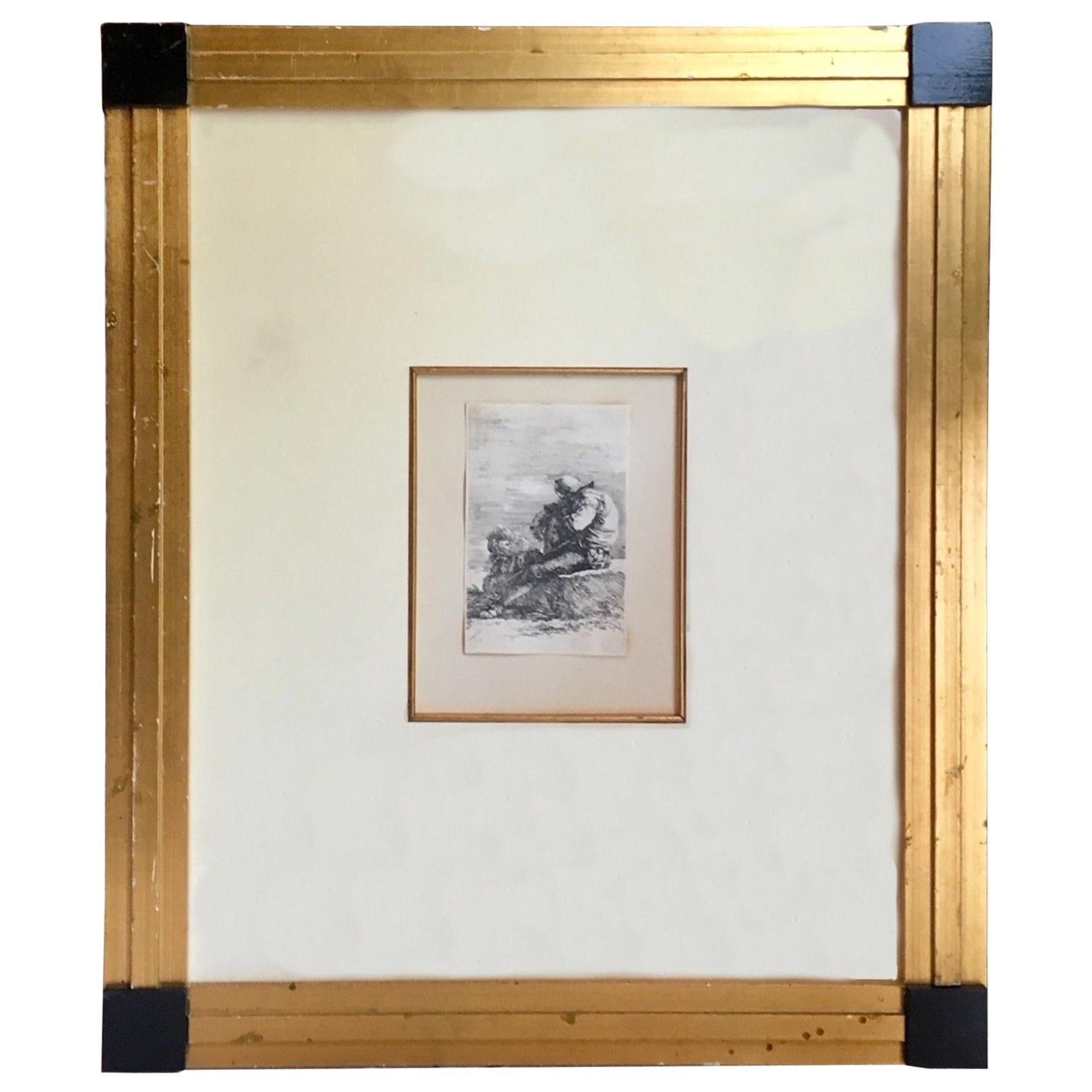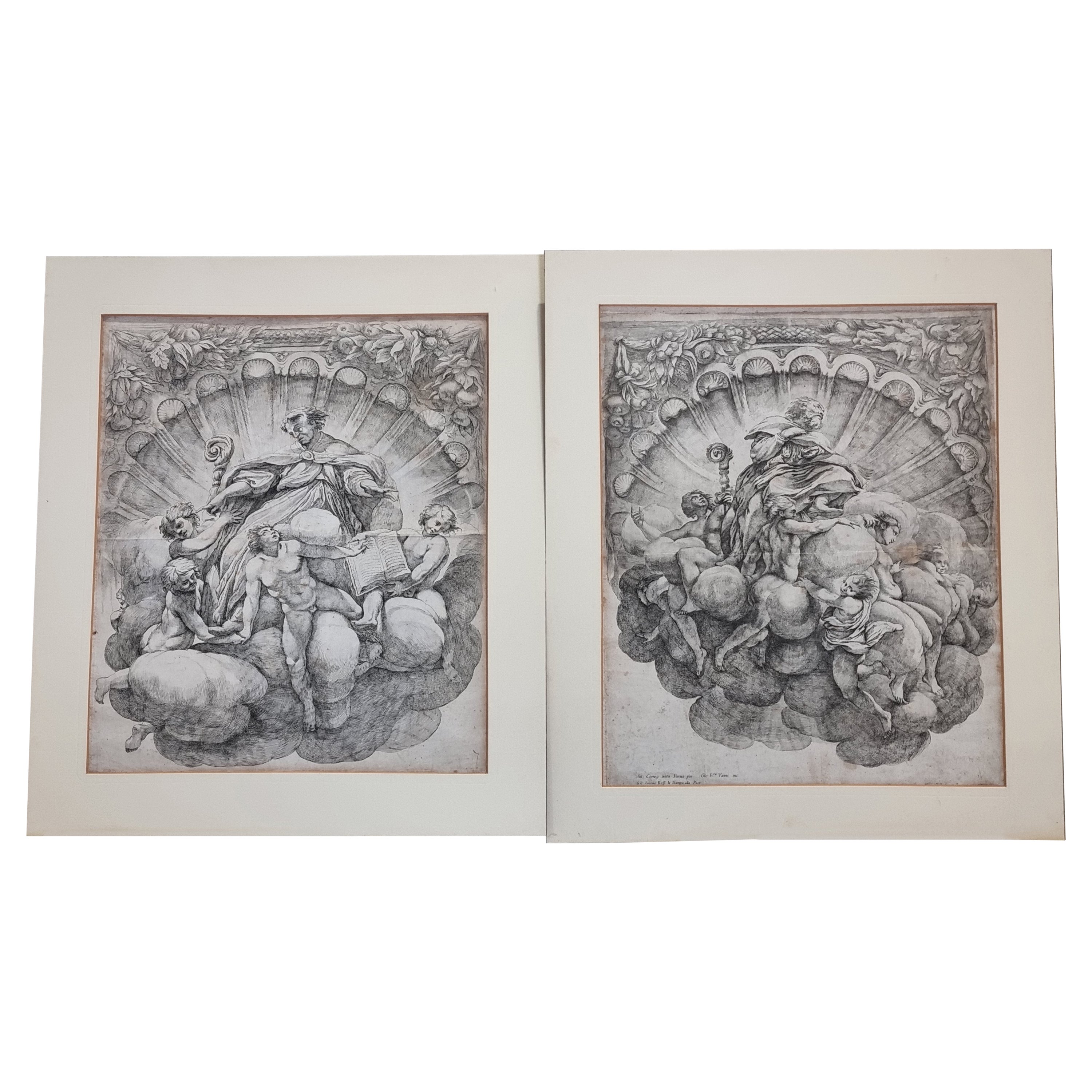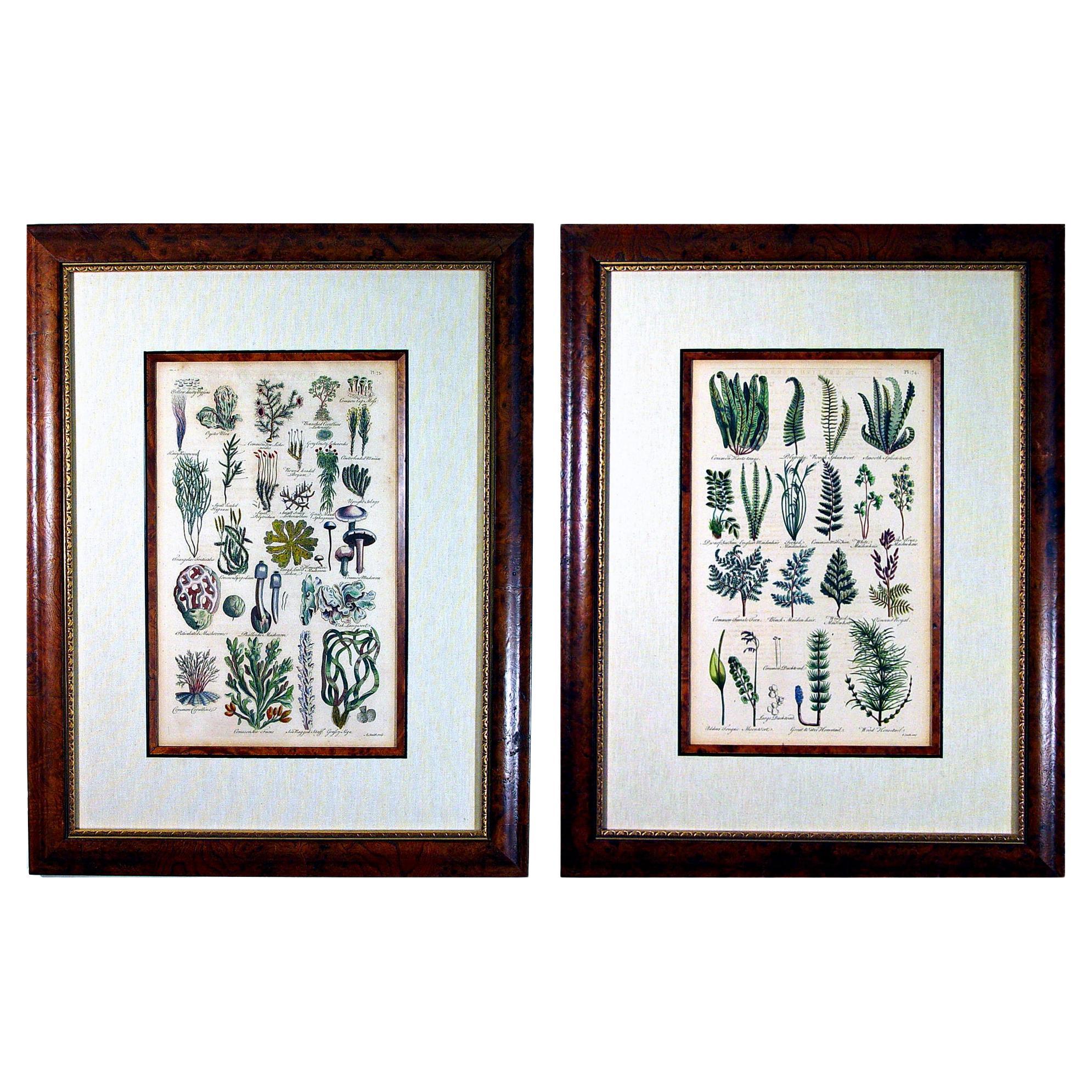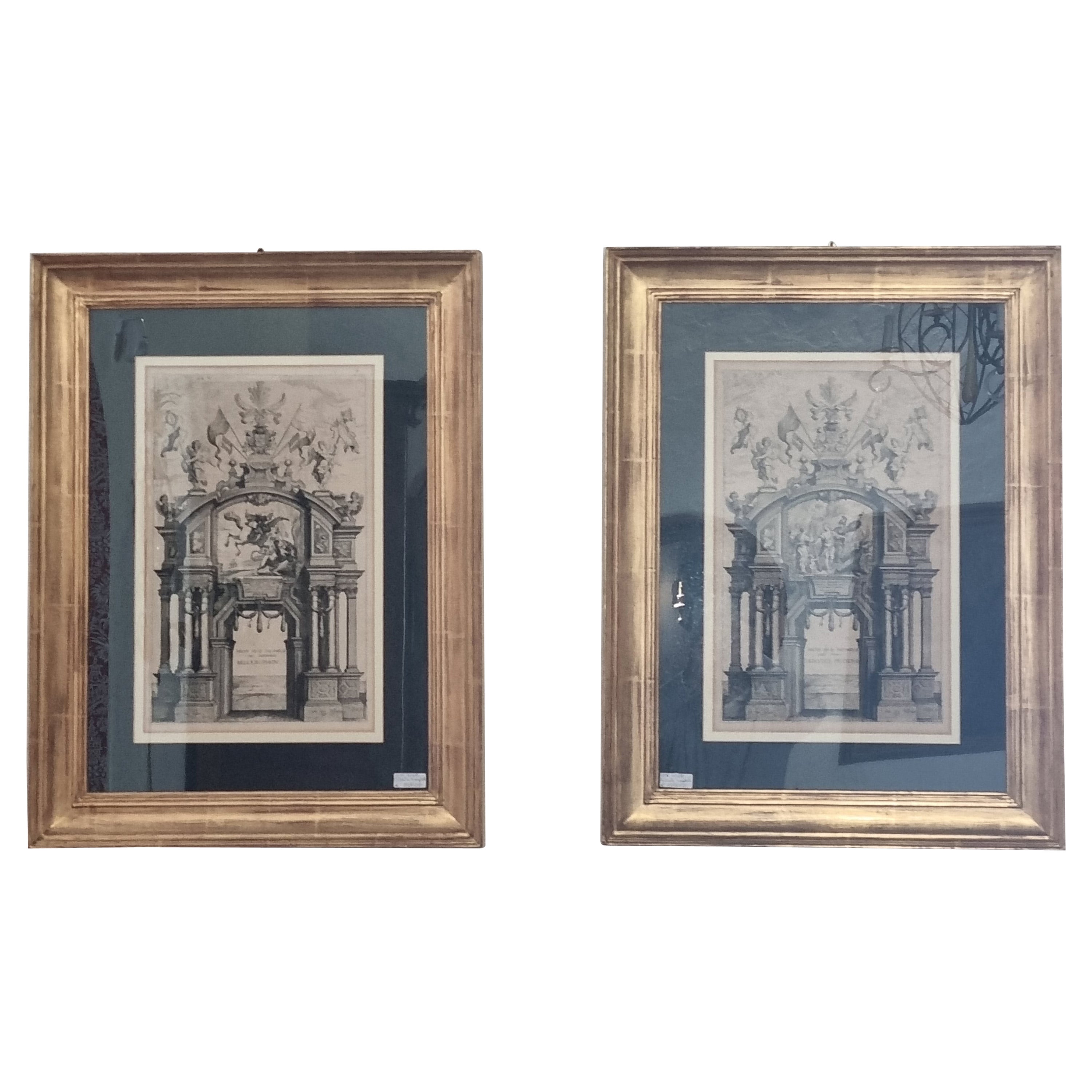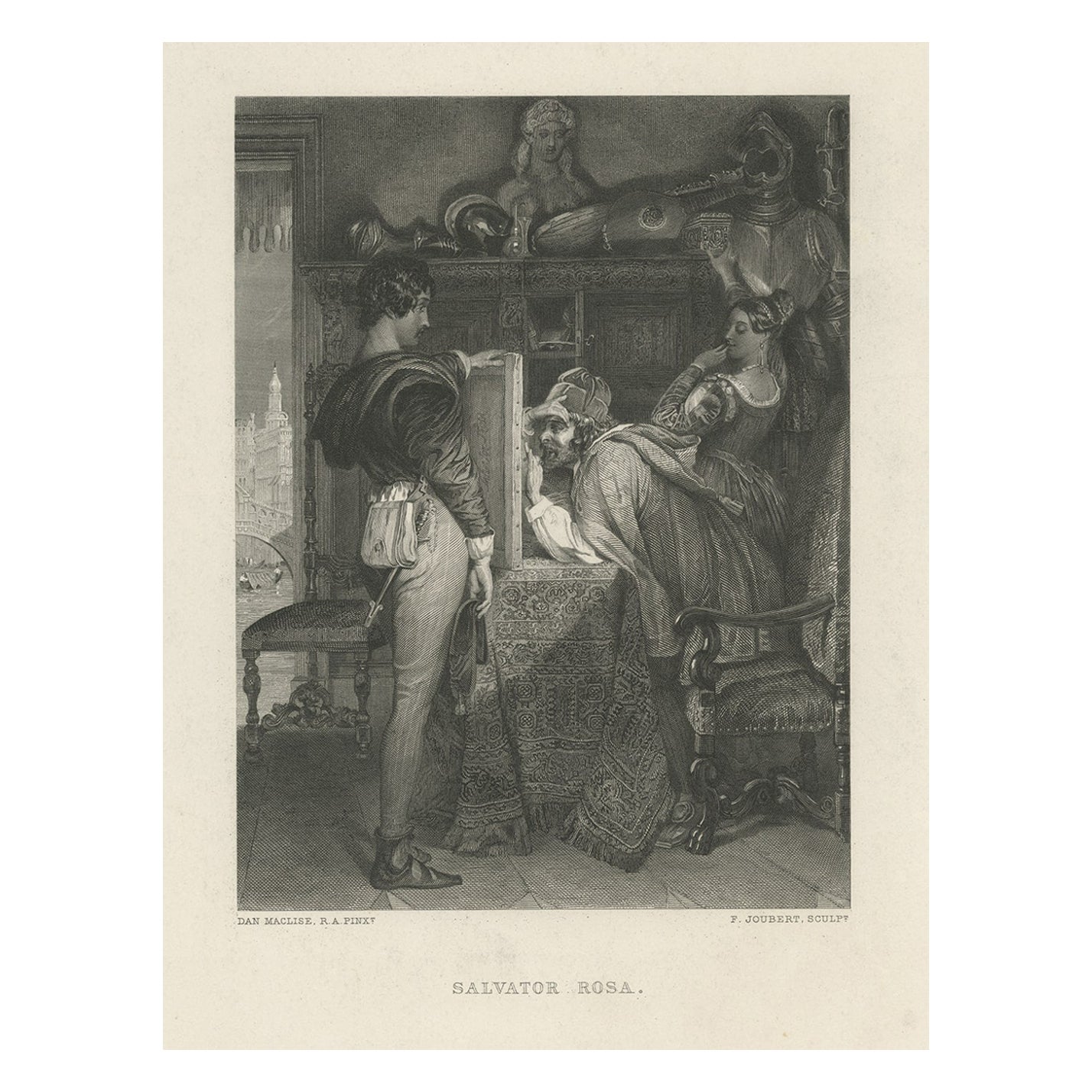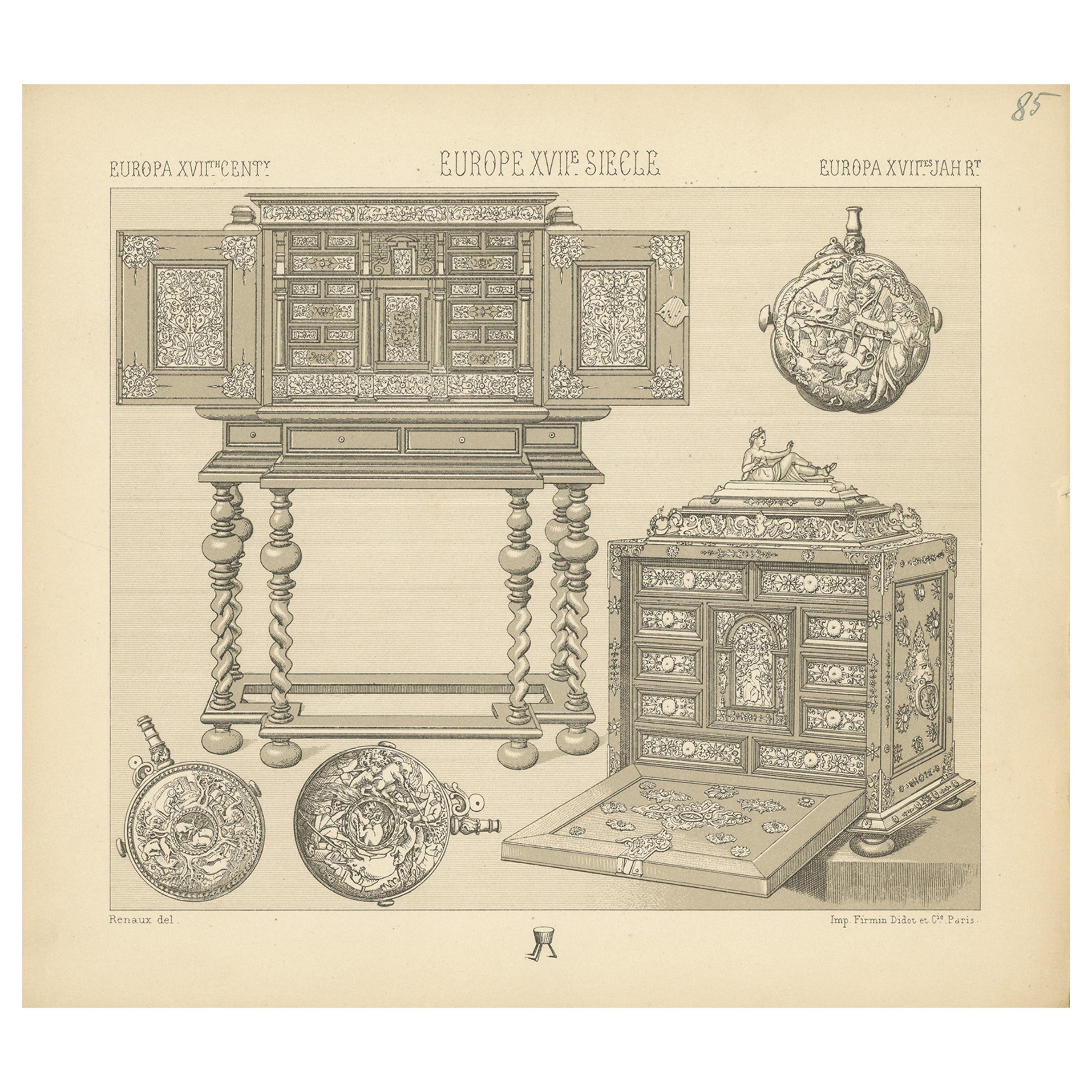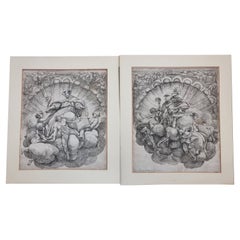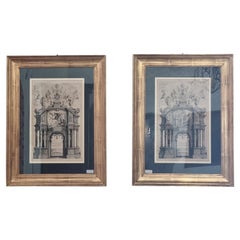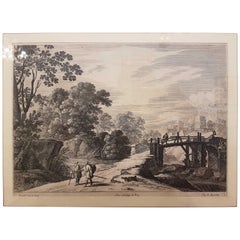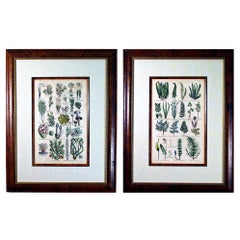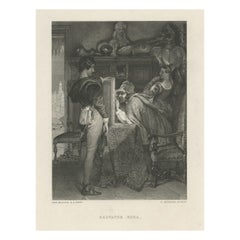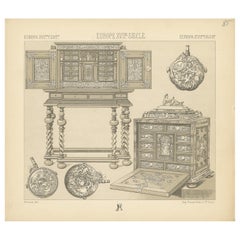Items Similar to 17th Century Etchingn and Drypoint" Ceres and Phytalus" by Salvator Rosa, 1662
Want more images or videos?
Request additional images or videos from the seller
1 of 11
17th Century Etchingn and Drypoint" Ceres and Phytalus" by Salvator Rosa, 1662
About the Item
" Ceres and Phytalus"
To left, Phytalus, kneeling, receives the fig tree from the goddess Ceres, standing to right, as a reward for his hospitality. Etching and drypoint, circa 1662, signed at lower center.
Example of the second state of two with the plate retouched in Phytalus's right foot and in the profile of Ceres, to which a third lock of hair is also added.
A fine impression, printed on contemporary laid paper with "fluer-de-lys in a circle with grapes" watermark, wide margins, very good condition.
The work describes the myth of Ceres that, hosted by Phytalus in his home, gives him the fig tree, which was hitherto unknown to men, as a sign of gratitude.
Some scholars argue that the subject is inspired by the Life of Theseus of Plutarch and others that the work is more banally due to the predilection of the artist for the fruit of the fig tree.
The work is mentioned in a letter written by Salvator Rosa to his friend Ricciardi in 1662 from his hermitage in the villa of Strozzavolpe near Poggibonsi, along with other famous works: Polycrates, Democritus, Alexander and Diogenes, Plato's Academy, Diogenes Throwing the Bowl, and the Death of Atilius Regulus. We can therefore conclude that 1662 was a particularly happy and fruitful year for the engraver Rosa, who linked his fame as a great graphic artist to the copperplates executed during this period. The subject depicted in our print illustrates the myth of Ceres who, hosted by Phytalius in his home, gives him the fig tree hitherto unknown to man, as a sign of gratitude. The source from which Rosa draws inspiration in her learned readings is to be found in Pausanias' Periegesis tes Ellados (I, 37, 24) or in Plutarch's Life of Theseus (chap. XXIII), but some critics have linked this subject with the artist's known predilection for the fig fruit, reported by his biographer Baldinucci. The scene depicted in the engraving appears marked by a classical composure, although it has been noted that the attitudes of the two figures derive from the mimicry of contemporary theatre, widely known and practised by the artist” (cfr. Massari, Tra Mito ed Allegoria, p. 446).
Bibliography: Bartsch / Le Peintre graveur (XX.275.19); Wallace 1979 / The Etchings of Salvator Rosa (112.II); Salamon 98; S. Massari, Tra Mito ed Allegoria, p. 446, 170, II/II.
Salvator Rosa ( Arenella, Kingdom of Naples 20th June or 2st July 1615 – Rome, Papal State 15th March 1673) was an Italian Baroque painter, engraver and poet whose romanticized landscapes and history paintings, often set in dark and untamed nature, exerted considerable influence from the 17th century into the early 19th century. In his lifetime he was among the most famous painters, known for his flamboyant personality, and regarded as an accomplished poet, satirist, actor, musician, and printmaker, as well. He was active in Naples, Rome, and Florence, where on occasion he was compelled to move between cities, as his caustic satire earned him enemies in the artistic and intellectual circles of the day.
As a history painter, he often selected obscure and esoteric subjects from the Bible, mythology, and the lives of philosophers, that were seldom addressed by other artists. He rarely painted the common religious subjects, unless they allowed a treatment dominated by the landscape element. He also produced battle scenes, allegories, scenes of witchcraft, and many self portraits. However, he is most highly regarded for his very original landscapes, depicting "sublime" nature: often wild and hostile, at times rendering the people that populated them as marginal in the greater realm of nature. They were the very antithesis of the "picturesque" classical views of Claude Lorrain and prototypes of the romantic landscape. Some critics have noted that his technical skills and craftsmanship as a painter were not always equal to his truly innovative and original visions. This is in part due to a large number of canvases he hastily produced in his youth (1630s) in pursuit of financial gain, paintings that Rosa himself came to loathe and distance himself from in his later years, as well as posthumously misattributed paintings.Many of his peopled landscapes ended up abroad by the 18th century, and he was better known in England and France than most Italian Baroque painters.
Rosa has been described as "unorthodox and extravagant", a "perpetual rebel","The Anti-Claude and a proto-Romantic. He had a great influence on Romanticism, becoming a cult-like figure in the late 18th and early 19th centuries, and myths and legends grew around his life, to the point that his real life was scarcely distinguished from the bandits and outsiders that roamed the wild and thundery landscapes he painted. By the mid 19th century however, with the rise of realism and Impressionism, his work fell from favor and received very little attention. A renewed interest in his paintings emerged in the late 20th century, and although he is not ranked among the very greatest of the Baroque painters by art historians today, he is considered an innovative and significant landscape painter and a progenitor of the romantic movement.
Please note: the release of the authorization for export by the Italian Ministry of Cultural Heritage takes about six weeks from the day of purchase.
- Creator:Salvator Rosa (Artist)
- Dimensions:Height: 14.06 in (35.7 cm)Width: 9.26 in (23.5 cm)Depth: 0.04 in (1 mm)
- Style:Baroque (Of the Period)
- Materials and Techniques:Paper,Other
- Place of Origin:
- Period:
- Date of Manufacture:1662
- Condition:Wear consistent with age and use.
- Seller Location:Cagliari, IT
- Reference Number:1stDibs: LU3136333645082
About the Seller
4.9
Gold Seller
Premium sellers maintaining a 4.3+ rating and 24-hour response times
Established in 1934
1stDibs seller since 2017
102 sales on 1stDibs
Typical response time: 5 hours
- ShippingRetrieving quote...Shipping from: Cagliari, Italy
- Return Policy
Authenticity Guarantee
In the unlikely event there’s an issue with an item’s authenticity, contact us within 1 year for a full refund. DetailsMoney-Back Guarantee
If your item is not as described, is damaged in transit, or does not arrive, contact us within 7 days for a full refund. Details24-Hour Cancellation
You have a 24-hour grace period in which to reconsider your purchase, with no questions asked.Vetted Professional Sellers
Our world-class sellers must adhere to strict standards for service and quality, maintaining the integrity of our listings.Price-Match Guarantee
If you find that a seller listed the same item for a lower price elsewhere, we’ll match it.Trusted Global Delivery
Our best-in-class carrier network provides specialized shipping options worldwide, including custom delivery.More From This Seller
View All17th Century Pair of Burin Prints by Giovanni Battista Vanni, Italy, 1642
By Giovanni Battista Vanni, Antonio da Correggio
Located in Cagliari, IT
A beautiful pair of burin engravings depicting "Saint Bernardo degli Uberti" and "Saint Hilary of Poitiers" two of the patron saints of the city included in the base of the cupola ( dome ) of Parma cathedral frescoed by Antonio Allegri known as Correggio (Correggio, August 1489-Correggio 5 March 1534) between 1524 and 1530. Admirable work by the great master in which his genius as a forerunner of the Baroque is fully seen.
In 1642 Giovanni Battista Vanni etched a series of fifteen plates from Correggio's frescoes.
Giovanni Battista Vanni was born in Pisa around 1599; he studied successively under Jacopo da Empoli, Aurelio Lomi, and Matteo Rosselli, and then became a disciple of Cristofano Allori. He is better known as an engraver than as a painter. From 1624 to 1632, he lived in Rome, then returning to Florence after visiting Venice.
In addition to the series of prints...
Category
Antique 17th Century Italian Baroque Prints
Materials
Paper
17th Century Pair of Etchings by Theodoor Van Thunlden from Rubens, Antwerp 1642
By Theodoor van Thulden, Peter Paul Rubens
Located in Cagliari, IT
"Arch dedicated to Hercules" and "Arch dedicated to Bellerophon"
Splendid and very rare etchings belonging to a suite of subjects executed for the preparations of the "Celebrations for the entry into Antwerp of the Cardinal-Infante Ferdinando of Habsburg-Spain on 17 April 1635".
The sketches for the decorations were all drawn by Sir Peter Paul Rubens and the execution of the etchings was entrusted to Van Thulden.
Bottom left: P.P. Rubens. Bottom right: G. Gervatius (who was commissioned to bring together the illustrations of the arches in a special volume) and Van Thulden.
Laid paper with watermark - copper imprint - margins - excellent condition.
At the end of 1634 Peter Paul Rubens (1577-1640) was invited to make a series of drawings to decorate the city of Antwerp on the occasion of the solemn entry of the infant cardinal Ferdinand of Habsburg (1609-1641) who, after his death of Archduchess Isabella Clara Eugenia (1633), Spanish governor of the southern Netherlands, had been elected as his successor. Generally in these circumstances, the itinerary was articulated through a series of stations and the city - in its main urban hubs - was adorned with decorations and ephemeral apparatuses which, without solution of continuity, covered the facades of the palaces, churches and convents facing the parade axis of the celebratory itinerary, testifying to the participatory role of the various public and private institutions that took part in the feast1. As had happened for the entrances of Charles V in 1520, of Philip II in 1549 and of the archdukes Albert and Isabella in 1599, also in this case, on 17 April 1635, the most important streets and squares of Antwerp were enriched with arrangements: temporary altars, four scenarios, a portico and large triumphal arches built in wood, over twenty meters height, decorated with paintings, sculptures and allegorical scenes. The references to the ancient alluded in this case to the greatness of the Habsburgs and to the merits of Ferdinand for the victory obtained over the Protestant armies of Sweden and their German allies. The choice to use the triumphal arch has its roots in the "city of the popes" and must be read as a connection with the triumphal and modern arches, with Rome and with the "possession" ceremony, placing the emphasis on its centuries-old use . In the elaboration of the drawings and sketches Rubens proved to be a true connoisseur of architecture, but what is most surprising about the artist is the casual use of architectural language and fidelity to sixteenth-century Roman models. In order for the memory of these works to be perpetuated over time, some artists were commissioned to etch the ephemeral apparatuses and, under the guidance of the painter Theodor van Thulden...
Category
Antique 17th Century Belgian Baroque Prints
Materials
Paper
$2,785 Sale Price
20% Off
17th Century Gabriel Perelle "Landscape" Etching, France, circa 1660
By Gabriel Perelle
Located in Cagliari, IT
A French landscape by Gabriel Perelle. With a modern walnut frame
Gabriel Perelle (Vernon, 1604 - Paris, 1677) was a French engraver, draftsman and printer of topographic views and landscapes.
A pupil of Simon Vouet, Perelle specialized in landscapes with a classical setting, not unlike those of Francisque Millet, although with clearly decorative pretensions. He founded an etching lab, with the collaboration of his sons Nicolas and Adam.
Perelle was also a pupil of Daniel Rabel and produced hundreds of engravings from his drawings, as well as compositions by fellow antagonists such as Israël Silvestre, Paul Bril, Jacques Callot, Michel Corneille the Elder, Jan Asselijn...
Category
Antique 1660s French Baroque Prints
Materials
Paper
$538 Sale Price
20% Off
17th Century Francesco Curti "Vendor of Shoes" Etching
By Giuseppe Maria Mitelli, Francesco Curti
Located in Cagliari, IT
The print is part of the series consisting of forty engravings, "I mestieri per la via" (The crafts on the road), engraved by Francesco Curti (Bologna ca.1603- Bologna 1670) by an in...
Category
Antique 1660s Italian Prints
Materials
Copper
$185 Sale Price
50% Off
17th Century Flaemish Abraham Genoels II "Landscape with Rabbit" Etching
By Abraham Genoels II
Located in Cagliari, IT
Beautiful etching by Abraham Genoels II (Antwerp 1640-1723) from a painting by Adam Frans van der Meulen (Brussels 1844-Paris 1690).
Excellent state of conservation with wide margin...
Category
Antique Late 17th Century Belgian Prints
Materials
Copper
$910 Sale Price
20% Off
17th Century Jan Van De Velde Print "October" from the Months, 1618
By Jan Van de Velde, Claes Jansz. Visscher (II)
Located in Cagliari, IT
Beautiful burin from the rare suite "The Months" performed by the artist and engraved by Claens Jansz Visscher (1587-19 June 1652).
Very fresh and well contrasted, laid paper with w...
Category
Antique 1610s Dutch Prints
Materials
Paper
$912 Sale Price
20% Off
You May Also Like
Fine 17th Century Italian Etching by Salvator Rosa, 1615-1673
By Salvator Rosa
Located in Vero Beach, FL
Salvator Rosa, the Italian Baroque painter was also a significant etcher and printmaker. Rosa’s is series of small prints of soldiers was very popular and influential. This etching i...
Category
Antique 17th Century Italian Baroque Prints
Materials
Paper
$630 Sale Price
40% Off
17th-Century Botanical Engravings of Mosses and Ferns By John Parkinson
By John Parkinson
Located in Downingtown, PA
John Parkinson was the last of the great English herbalists and one of the first of the great English botanists. Here the pair of prints show mosses and lichen and the other of ferns.
From: Paradisi in sole Paradisus Terrestris: or a garden of all sorts of pleasant flowers...
Category
Antique 1620s English Jacobean Prints
Materials
Paper
Old Steel Engraving of Salvator Rosa, an Italian Baroque Painter and Poet, c1890
Located in Langweer, NL
Description: Antique print titled 'Salvator Rosa'. Steel engraving of Salvator Rosa, an Italian Baroque painter, poet, and printmaker, who was active in Naples, Rome, and Florence.
Artists and Engravers: D. Appleton & Company was an American company founded by Daniel Appleton (December 10, 1785 – March 27, 1849), who opened a general store which included books. He published his first book in 1831. The company's publications gradually extended over the entire field of literature. It issued the works of contemporary scientists at moderate prices, for example, Herbert Spencer...
Category
Antique 1890s Prints
Materials
Paper
Pl 85 Antique Print of European 17th Century Furniture by Racinet
Located in Langweer, NL
Antique print titled 'Europa XVIIth Cent - Europe XVIIe Siecle - Europa XVIItes Jahr'. Chromolithograph of European 17th century furniture. Thi...
Category
Antique Late 19th Century Prints
Materials
Paper
Pl 96 Antique Print of European 17th Century Costumes by Racinet
Located in Langweer, NL
Antique print titled 'Europa XVIIth Cent - Europe XVIIe Siecle - Europa XVIItes Jahr'. Chromolithograph of European 17th century costumes. This p...
Category
Antique Late 19th Century Prints
Materials
Paper
Pl. 105 Antique Print of European 17th-18th Century Objects by Racinet
Located in Langweer, NL
Antique print titled 'Europa XVII, XVIIIth Cent - Europe XVII, XVIIIe Sele - Europa XVII, XVIIItes Jahr'. Chromolithograph of European 17th-18th century objects. This print originate...
Category
Antique Late 19th Century Prints
Materials
Paper
